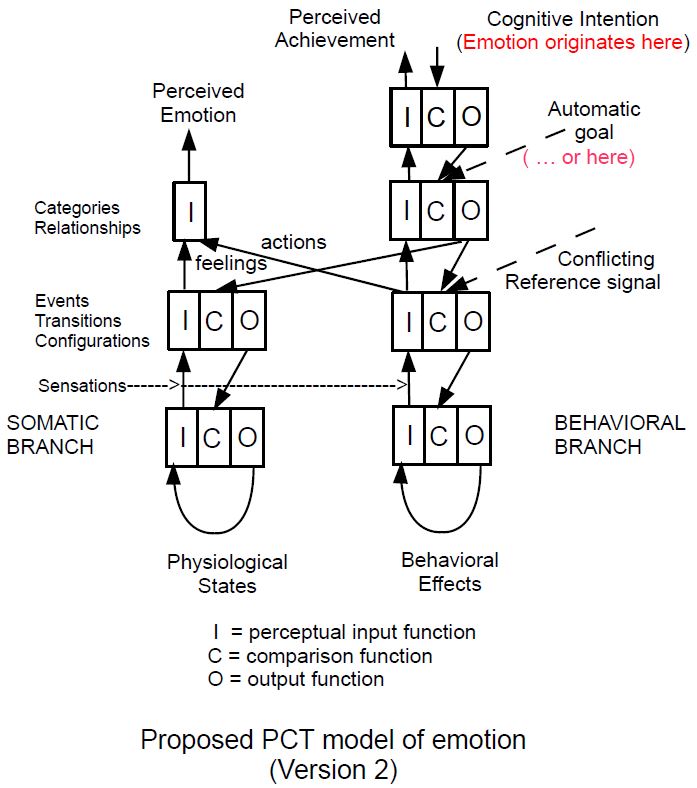Hi Bruce, it would be amazing of you could find the source of that diagram as I would like to reproduce it… That said, wouldn’t we expect that primitive emotional systems would utilise (prepared) behaviours to control their (prepared) perceptions? They don’t just control somatic states…
Warren
The ‘somatic states’ are sensed (body-internal) environmental consequences of somatic preparations.
A search of the CSGnet archive should turn it up. But first, ask Dag.
Everybody should have the Book of Readings.
but I have just added Bill’s 3-page overview which Dag reprinted there.
(I printed the page range to PDF. The Adobe print-to-PDF function refused to print an encrypted file, but the corresponding Microsoft function did it without complaint.)
Here is Bill’s post about the diagram and the text:
Emotion revisited
Attachment Converted: "M:\File CSG archive\EmotionModelV2.pdf" Attachment Converted: "M:\File CSG archive\FeelingAndAction.doc"
[From Bill Powers (2009.11.10.1036 MDT);
Bruce Abbott and I have been discussing emotion again, off-net,
trying to find agreeable ways of stating the conventional and the PCT
theories of emotion in a way that would be accepted as correct by
proponents on either side. Bruce is tied up right now with his annual
revision of his methods book, so I’m posting a paper and a diagram
that have resulted from our discussions so far, to see what others
have to say about them.
The diagram is incomplete, partly on purpose to avoid cluttering it
up. The ICO representation doesn’t show the perceptual and error
signals connecting the functions, but anyone familiar with the
standard PCT diagram can imagine them. The purpose of the diagram is
to show how a high-level goal results both in actions and in a
perception of emotion that arises from the combination of perceived
action and perceived feelings (from changes in physiological state).
Single systems are shown but they could be multiple. Also, the action
component of the emotion could be supplied by the imagination
connection from the system on the right second from the top, so even
imagining the action can result in perception of an emotion.
The notations about my levels, on the left, are purely speculative.
Note that emotions are perceptions, not objective states of the whole system.
Also not shown are disturbances that enter at various levels with
various emotional consequences. A disturbance of the top or
next-to-top system’s perception, for example, might result from
signals from uncontrolled perceptions of lower level (as in the lion
example in the paper), resulting in emotions. Not shown also are
effects from other systems at the higher levels that end up causing
conflict and preventing action. I’ll try to work more of those things
into the diagram, but don’t want to make it an incomprehensible mess.
I drew the diagram using the free Open Office “draw” program, which
generates vector graphics that scale up and down without pixelation
problems. This program can export the result as a pdf file, still in
vector graphics which the pdf format recognizes, so you can zoom in
and out without seeing any jaggies. Print it out: it’s very pretty.
Best,
Bill P.
Thanks Adam!
Yes, we are working to get these things back into print.
Here is Plutchik’s categorization of emotions:
It can be used for organizing data and for clarity of terminology and discourse. The analogy to color theory and the mixing of colors provides a way to categorize the several hundred emotions terms, and he reports good agreement among subjects as to what term applies to a secondary mixture of two of the eight primary terms, and on out to more subtle tertiary etc. mixtures.
His 2001 paper from American Scientist (89) is on JSTOR if you have institutional access (or a paid subscription).
I put a copy in Dropbox here (with unfortunately degraded images) that I downloaded to avoid the Springer paywall. It’s is still there at eva.fcs.edu.uy though that faculty have migrated to eva.fcs.udelar.edu.uy.
Plutchik’s eight-fold primary categorization (four pairs of opposites) may indeed correspond to preconscious ‘snap judgement’ perceptions that the limbic system constructs. Plutchik’s account in terms of evolution seems plausible. Under his ‘physiology’ rubric, Plutchik identifies eight modalities of limbic preparation for action, with obvious evolutionary relevance.
Thanks Bruce!
